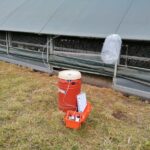MANAGE ODOUR EMISSIONS FOR YOUR ENVIRONMENTAL PERMIT

[vc_row][vc_column][vc_column_text]
HOW TO CONTROL ODOUR EMISSIONS FOR YOUR ENVIRONMENTAL PERMIT
[/vc_column_text][vc_column_text]Do you manage a site that needs an environmental permit in order to operate? If you do, then you must control and monitor odour emissions from this site. At Silsoe Odours, we understand that it can sometimes feel overwhelming to know where to start. So, in this article, we talk about the steps you need to take to prevent odour nuisance and comply with your permit.[/vc_column_text][vc_separator][/vc_column][/vc_row][vc_row][vc_column][vc_column_text]
CONDUCT A THOROUGH RISK ASSESSMENT
[/vc_column_text][vc_column_text]To start with, carry out a full risk assessment of your odour emissions. Make sure you identify existing and potential odour emissions at your site. You can do this internally, or you may wish to engage a specialist odour consultancy to help you. Here are some areas to look at.
- Establish where there are possible sources of odour emissions from your site.
- Think about who might be affected by possible odours from your site. For example, are there houses, workplaces, schools or hospitals nearby?
- What will you do to monitor and minimise odour? Build this into your daily best practise routines.
- What will you do to control odour if it becomes problematic?
[/vc_column_text][/vc_column][/vc_row][vc_row][vc_column width=”1/4″][vc_column_text] [/vc_column_text][/vc_column][vc_column width=”1/4″][vc_column_text]
[/vc_column_text][/vc_column][vc_column width=”1/4″][vc_column_text] [/vc_column_text][/vc_column][vc_column width=”1/4″][vc_column_text]
[/vc_column_text][/vc_column][vc_column width=”1/4″][vc_column_text] [/vc_column_text][/vc_column][vc_column width=”1/4″][vc_column_text]
[/vc_column_text][/vc_column][vc_column width=”1/4″][vc_column_text] [/vc_column_text][/vc_column][/vc_row][vc_row][vc_column][vc_column_text]Finally, build your risk assessment into your management system and incorporate a complaints management procedure. If you are applying for a new or varied permit, include this risk assessment as part of your permit application.[/vc_column_text][vc_btn title=”Learn more: “Risk assessments for your environmental permit“ (Source: www.gov.uk)” color=”white” size=”xs” link=”url:https%3A%2F%2Fwww.gov.uk%2Fguidance%2Frisk-assessments-for-your-environmental-permit|||”][vc_separator][/vc_column][/vc_row][vc_row][vc_column][vc_column_text]
[/vc_column_text][/vc_column][/vc_row][vc_row][vc_column][vc_column_text]Finally, build your risk assessment into your management system and incorporate a complaints management procedure. If you are applying for a new or varied permit, include this risk assessment as part of your permit application.[/vc_column_text][vc_btn title=”Learn more: “Risk assessments for your environmental permit“ (Source: www.gov.uk)” color=”white” size=”xs” link=”url:https%3A%2F%2Fwww.gov.uk%2Fguidance%2Frisk-assessments-for-your-environmental-permit|||”][vc_separator][/vc_column][/vc_row][vc_row][vc_column][vc_column_text]
MEET YOUR PERMIT CONDITIONS
[/vc_column_text][vc_column_text] As part of your environmental permit, the regulator will set specific objectives, or conditions, around your odour emissions. They will design these conditions to minimise pollution. In this case, the potential pollution is an offence to a human sense (smell). Usually, you will be able to decide how to meet these conditions. However, if your site poses a particularly high risk of malodours, your condition may stipulate that you employ specific equipment or actions.
As part of your environmental permit, the regulator will set specific objectives, or conditions, around your odour emissions. They will design these conditions to minimise pollution. In this case, the potential pollution is an offence to a human sense (smell). Usually, you will be able to decide how to meet these conditions. However, if your site poses a particularly high risk of malodours, your condition may stipulate that you employ specific equipment or actions.
You must comply with all the conditions in your permit. If you don’t, you may lose your permit (temporarily or permanently). You could even be acting illegally. With this in mind, it is essential to understand each condition and make sure your site deals with them appropriately.[/vc_column_text][vc_btn title=”Learn more: “Control and monitor emissions for your environmental permit“ (Source: www.gov.uk)” color=”white” size=”xs” link=”url:https%3A%2F%2Fwww.gov.uk%2Fguidance%2Fcontrol-and-monitor-emissions-for-your-environmental-permit|||”][vc_separator][/vc_column][/vc_row][vc_row][vc_column][vc_column_text]
HAVE AN EFFECTIVE ODOUR MANAGEMENT PLAN
[/vc_column_text][vc_column_text]You will find your odour management plan to be a useful weapon in your battle to control odour emissions. In the first instance, when you apply for an environmental permit, you will be able to use it to demonstrate how you plan to control odour. Once you are up and running, it will help you prevent and/or minimise odour on an ongoing basis.
You can refer to the Environment Agency’s ‘H4 odour guidance – how to comply with your environmental permit’ for detailed support in putting together your odour management plan. Alternatively, please speak to our team of odour specialists on 01525 860222. But for now, here is the kind of thing you should take into account.[/vc_column_text][vc_column_text css=”.vc_custom_1623924933148{margin-top: 0px !important;margin-right: 0px !important;margin-bottom: 0px !important;margin-left: 0px !important;border-top-width: 20px !important;border-right-width: 20px !important;border-bottom-width: 20px !important;border-left-width: 20px !important;padding-top: 20px !important;padding-right: 20px !important;padding-bottom: 20px !important;padding-left: 20px !important;background-color: rgba(184,180,218,0.33) !important;*background-color: rgb(184,180,218) !important;border-left-color: #cdcbd8 !important;border-right-color: #cdcbd8 !important;border-top-color: #cdcbd8 !important;border-bottom-color: #cdcbd8 !important;}”]
Responsibility for your odour management plan
You should appoint specific people to be responsible for the operation of your odour management plan. Make sure you include their contact details.
Sources of odour emissions
Consider all possible odour sources, as well as how emissions will vary depending on time and date.
Mitigation
Look at your odour abatement equipment and how you intend to measure its effectiveness. You should also create a good management system to ensure equipment is well maintained. It is a good idea to appoint specific people to hold responsibility for each task.
Odour emissions monitoring
Appoint specific staff to monitor odour regularly. Ensure they complete odour sensitivity testing and are compliant with EN13725 requirements. In addition, build in regular odour sampling to check your odour emissions remain under control.
Complaints management
If you actively manage odour in line with the steps above, you are unlikely to receive many odour complaints. However, you must ensure you respond positively to any complaints that do come in.[/vc_column_text][/vc_column][/vc_row][vc_row][vc_column][vc_separator][vc_column_text]
CHOOSE ACCREDITED SUPPLIERS & PROCEDURES
[/vc_column_text][vc_column_text]

Silsoe Odours is a trusted partner to manage your odour emissions, holding UKAS accreditation for both odour sampling and testing.
Your permit may include specific directions relating to monitoring your odour emissions. This is to make sure you do not exceed the odour pollution conditions in your permit. When you conduct odour monitoring, you must make sure you comply with all appropriate regulations. For example:
‘Sniff survey’ monitoring
Odour panellists must comply with the European odour standard BSEN13725:2022. For the most trustworthy data, you should use a UKAS accredited odour laboratory for regular monitoring. You should also conduct more frequent (ideally, daily or weekly) monitoring using internal staff. Appoint specific individuals, and ensure they have completed odour sensitivity (or acuity) testing. Without doing so, they do not comply with BSEN13725:2022.
Odour sampling
For more detailed, quantitative data relating to your odour emissions, choose an odour sampling survey. You can opt for a UKAS accredited team to collect the samples and analyse them at a UKAS accredited laboratory. Alternatively, you can take samples internally, providing you do so in line with the specifications of BSEN13725:2022. You can then send them to a UKAS accredited laboratory for analysis.
Odour abatement equipment
Choose a reputable supplier who can demonstrate the effectiveness of the equipment for your site. You should ask them to test the equipment once it is in situ, for assurance of its long term capability.[/vc_column_text][vc_separator][/vc_column][/vc_row][vc_row][vc_column][vc_column_text]
TAKE CHARGE OF YOUR ODOUR EMISSIONS
[/vc_column_text][vc_column_text]Sometimes it feels daunting to address odour emissions. However, if you put a sensible, well-informed plan in place, you can manage emissions proactively and effectively. The team here at Silsoe Odours can also help. We have many years of experience and established technical expertise in odour management. We are also experienced across many different industry sectors, which means we can find a solution that is just right for your needs. Please call the team on 01525 860222 to see how we can help you understand where to focus your energies. Alternatively, you can reach us using the button below.[/vc_column_text][vc_btn title=”For support managing your odour emissions, click here or call 01525 860222″ color=”primary” size=”lg” align=”center” link=”url:https%3A%2F%2Fsilsoeodours.com%2Fcontact-us%2F|||” button_block=”true”][vc_separator][vc_column_text]
Updated 30th March 2022
[/vc_column_text][/vc_column][/vc_row]

